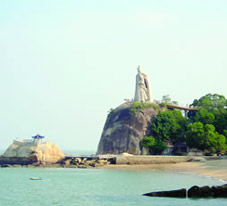
I feel in love with Gulangyu Island while dining in a 27th floor restaurant above the Lujiang River in Xiamen on the eve of the Mid-Autumn Festival. On the river, under the bright full moon, the small island outlined in lights looked like a crystal palace.
"Gulang" in Chinese means "drum waves", because the southwestern reefs when hit by the waves make sounds like drum beats. The sound made me decide to take a one-day trip to the island although local friends told me that the only transportation on the island would be my legs. There were no vehicles on the island apart from one fire engine, one police car and one ambulance.
Garden on the sea
As advised by my local friends, I bought a 75-yuan (US$9) ticket for all the famous scenic spots including Sunshine Rock, Full Moon Garden and Shuzhuang Garden when I stepped off the ferry.
There I found that the island did have some transport - some environmentally friendly electric buggies for tourists. But the price was too high, starting at 20 yuan. So I decided to explore the island on foot.
Sunshine Rock is the highest point on Gulangyu and after climbing to the top of the huge rock, I had a panoramic view of the whole island. The landscape and man-made constructions are blended harmoniously to form a special beauty which really makes the island deserve its other name: Sea Garden.
At the foot of Sunshine Rock is Shuzhuang Garden. Exquisitely designed in harmony with its topography, the garden boasts the Forty-Four Bridge, the Meishou Hall, and the Tingchao (Tide Listening) Tower.
The walls on the over-100-metre-long bridge look like dragons moving through the ocean. I felt as if I was walking on the sea with the tides coming and going and the salt-sea wind blowing in my face.
Piano island
A highly recommended spot is the Piano Museum located in Shuzhuang Park, the only one in China with exhibits of world-famous pianos, some more than a century old and coming from Germany, France, the US and Austria. In addition to having a close look at some 100 pianos from various eras, the tour guides present an excellent introduction to the history of the instrument.
So Gulangyu has another name - "Piano Island", deriving from its unique cultural atmosphere. Strolling on the island, one can frequently hear beautiful piano melodies.
The island also deserves the name because its 17,800 permanent residents own 620 pianos. Many famous Chinese pianists, such as Yin Chengzong and Xu Feiping, are natives of Gulangyu.
The Full Moon Garden commemorates the national hero Zheng Chenggong who recaptured Taiwan during the Ming Dynasty (1368-1644).
There is a hall of micro-sculptures of the hero and a hall of bronzes on the same theme. There is also a giant statue of Zheng, 15.7 metres high, weighing 1,400 tons and made of 635 granite blocks. It has become the symbol of Gulangyu.
Trace of history
The most exciting thing about any trip is to find something unexpected. On my trip I came across examples of ancient architecture and the Xiamen Municipal Museum.
Although I have seen a lot old buildings in Shanghai, the architecture on the island -- a combination of Western and Chinese styles -- amazed me. A couple of times, I quietly opened steel carved doors just for a closer look at large gardens, carved wood windows or centuries-old houses with huge pillars.
I wondered why there were so many beautiful buildings in Chinese, British, Japanese, Spanish and Italian styles all over the island until I visited the Xiamen Museum.
The exhibits in the museum show that the history of the small island is full of tears and struggles. Xiamen was one of the first victims of the European conquests in China after the Opium Wars (1840-1842). Then the island was split off from Xiamen (then called Amoy). A few hundred European and American traders prospered and built their mansions, living a presumably enviable bourgeois life.
In addition, the building of the museum, a Bagua (Eight Diagrams) Building is marvelous.
Finally, I would suggest visitors spend a night on the now tranquil island, walk along the seaside, enjoy the moonlight and listen to the sound of waves on the beach with a loved one. I did that too.
(Shanghai Star October 24, 2003)
|

